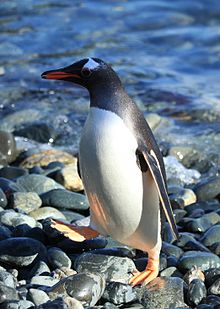
Gentoo Penguin
Did you know...
SOS Children produced this website for schools as well as this video website about Africa. Visit the SOS Children website at http://www.soschildren.org/
| Gentoo Penguin | |
|---|---|
 |
|
| In Cooper Bay, South Georgia, British Overseas Territories | |
| Conservation status | |
 Near Threatened ( IUCN 3.1) |
|
| Scientific classification | |
| Kingdom: | Animalia |
| Phylum: | Chordata |
| Class: | Aves |
| Order: | Sphenisciformes |
| Family: | Spheniscidae |
| Genus: | Pygoscelis |
| Species: | P. papua |
| Binomial name | |
| Pygoscelis papua ( Forster, 1781) |
|
 |
|
| Distribution of the Gentoo Penguin | |
The long-tailed Gentoo penguin (pron.: / ˈ dʒ ɛ n t uː / JEN-too), Pygoscelis papua, is a penguin species in the genus Pygoscelis, most closely associated with the Adélie penguin (P. adeliae) and the Chinstrap penguin (P. antarcticus). The first scientific description was made in 1781 by Johann Reinhold Forster on the basis of Falkland Islands. They call in a variety of ways, but the most frequently heard is a loud trumpeting which is emitted with its head thrown back.
The application of Gentoo to the penguin is unclear. The Oxford English Dictionary notes that Gentoo used to be an Anglo-Indian term used as early as 1638 to distinguish Hindus in India from Muslims. The English term originated from the Portuguese gentio (compare " gentile"); in the 20th century the term came to be regarded as derogatory.
Taxonomy
The Gentoo penguin is one of three species in the genus Pygoscelis. Mitochondrial and nuclear DNA evidence suggests the genus split from other penguins around 38 million years ago, about 2 million years after the ancestors of the genus Aptenodytes. In turn, the Adelie Penguins split off from the other members of the genus around 19 million years ago, and the Chinstrap and Gentoo finally diverging around 14 million years ago.
Two sub-species of this penguin are recognised: Pygoscelis papua papua and the smaller Pygoscelis papua ellsworthii'
Description
The gentoo penguin is easily recognized by the wide white stripe extending like a bonnet across the top of its head and its bright orange-red bill. They have pale whitish-pink webbed feet and a fairly long tail - the most prominent tail of all penguins. Chicks have grey backs with white fronts. As the Gentoo penguin waddles along on land, its tail sticks out behind, sweeping from side to side, hence the scientific name Pygoscelis, which means "rump-tailed".
Adult Gentoos reach a height of 51 to 90 cm (20–36 in), making them the third largest species of penguin after the two giant species, the Emperor Penguin and the King Penguin. Males have a maximum weight of about 8.5 kg (19 lb) just before molting, and a minimum weight of about 4.9 kg (10.8 lb) just before mating. For females the maximum weight is 8.2 kg (18 lb) just before moulting, but their weight drops to as little as 4.5 kg (10 lb) when guarding the chicks in the nest. Birds from the north are on average 700 g (1.5 lb) heavier and 10 cm (4 in) taller than the southern birds. Southern Gentoo penguins reach 75–80 cm (30–31 in) in length. They are the fastest underwater swimming penguins, reaching speeds of 36 km/h. Gentoo are adapted to very harsh cold climates.
Breeding
The breeding colonies of gentoo penguins are located on ice-free surface. Colonies can be directly dependent on the shoreline but are also considerably located inland. They prefer shallow coastal areas and often nest between tufts of grass. In South Georgia, for example, breeding colonies are two kilometres inland. Whereas in colonies farther inland, where the penguins nest between tufts of grass, they shift location slightly every year because the grass may get trampled over time.
Gentoos breed on many sub- Antarctic islands. The main colonies are on the Falkland Islands, South Georgia and Kerguelen Islands; smaller populations are found on Macquarie Island, Heard Islands, South Shetland Islands and the Antarctic Peninsula. The total breeding population is estimated to be over 300,000 pairs. Nests are usually made from a roughly circular pile of stones and can be quite large, 20 cm high and 25 cm in diameter. The stones are jealously guarded and their ownership can be the subject of noisy disputes between individual penguins. They are also prized by the females, even to the point that a male penguin can obtain the favors of a female by offering her a nice stone.
Two eggs are laid, both weighing around 500 g. The parents share incubation, changing duty daily. The eggs hatch after 34 to 36 days. The chicks remain in the nests for about 30 days before forming creches. The chicks molt into sub-adult plumage and go out to sea at about 80 to 100 days.
Diet
Gentoos live mainly on crustaceans such as krill, with fish making up only about 15% of the diet. However, they are opportunistic feeders, and around the Falklands are known to take roughly equal proportions of fish (Patagonotothen sp., Thysanopsetta naresi, Micromesistius australis), crustaceans (Munida gregaria) and squid (Loligo gahi, Gonatus antarcticus, Moroteuthis ingens).
Threats
In the water, sea lions, leopard seals, and orca are all predators of the Gentoo. On land there are no predators of full grown Gentoos. Skua can steal their eggs; however, some other seabirds have managed to snatch their young.
Conservation status
The IUCN Red List lists the gentoo as "near threatened", due to a rapid decline in some key populations which is believed to be driving a moderate overall decline in the species population. Examples include the population at Bird Island, South Georgia, where the population fell by two thirds in 25 years.




